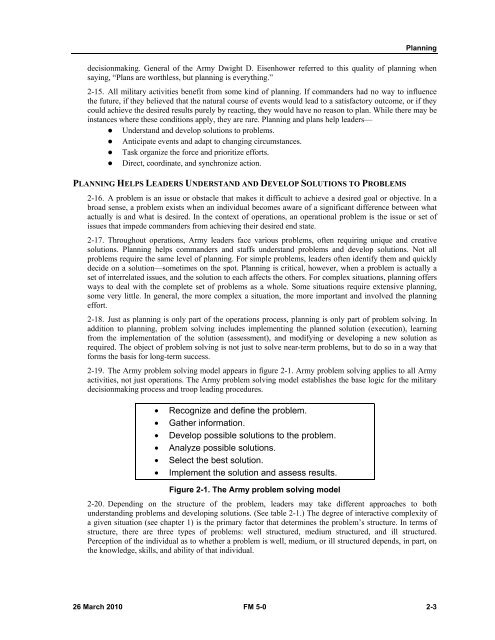FM 5-0, The Operations Process - Federation of American Scientists
FM 5-0, The Operations Process - Federation of American Scientists
FM 5-0, The Operations Process - Federation of American Scientists
You also want an ePaper? Increase the reach of your titles
YUMPU automatically turns print PDFs into web optimized ePapers that Google loves.
Planning<br />
decisionmaking. General <strong>of</strong> the Army Dwight D. Eisenhower referred to this quality <strong>of</strong> planning when<br />
saying, “Plans are worthless, but planning is everything.”<br />
2-15. All military activities benefit from some kind <strong>of</strong> planning. If commanders had no way to influence<br />
the future, if they believed that the natural course <strong>of</strong> events would lead to a satisfactory outcome, or if they<br />
could achieve the desired results purely by reacting, they would have no reason to plan. While there may be<br />
instances where these conditions apply, they are rare. Planning and plans help leaders—<br />
• Understand and develop solutions to problems.<br />
• Anticipate events and adapt to changing circumstances.<br />
• Task organize the force and prioritize efforts.<br />
• Direct, coordinate, and synchronize action.<br />
PLANNING HELPS LEADERS UNDERSTAND AND DEVELOP SOLUTIONS TO PROBLEMS<br />
2-16. A problem is an issue or obstacle that makes it difficult to achieve a desired goal or objective. In a<br />
broad sense, a problem exists when an individual becomes aware <strong>of</strong> a significant difference between what<br />
actually is and what is desired. In the context <strong>of</strong> operations, an operational problem is the issue or set <strong>of</strong><br />
issues that impede commanders from achieving their desired end state.<br />
2-17. Throughout operations, Army leaders face various problems, <strong>of</strong>ten requiring unique and creative<br />
solutions. Planning helps commanders and staffs understand problems and develop solutions. Not all<br />
problems require the same level <strong>of</strong> planning. For simple problems, leaders <strong>of</strong>ten identify them and quickly<br />
decide on a solution—sometimes on the spot. Planning is critical, however, when a problem is actually a<br />
set <strong>of</strong> interrelated issues, and the solution to each affects the others. For complex situations, planning <strong>of</strong>fers<br />
ways to deal with the complete set <strong>of</strong> problems as a whole. Some situations require extensive planning,<br />
some very little. In general, the more complex a situation, the more important and involved the planning<br />
effort.<br />
2-18. Just as planning is only part <strong>of</strong> the operations process, planning is only part <strong>of</strong> problem solving. In<br />
addition to planning, problem solving includes implementing the planned solution (execution), learning<br />
from the implementation <strong>of</strong> the solution (assessment), and modifying or developing a new solution as<br />
required. <strong>The</strong> object <strong>of</strong> problem solving is not just to solve near-term problems, but to do so in a way that<br />
forms the basis for long-term success.<br />
2-19. <strong>The</strong> Army problem solving model appears in figure 2-1. Army problem solving applies to all Army<br />
activities, not just operations. <strong>The</strong> Army problem solving model establishes the base logic for the military<br />
decisionmaking process and troop leading procedures.<br />
• Recognize and define the problem.<br />
• Gather information.<br />
• Develop possible solutions to the problem.<br />
• Analyze possible solutions.<br />
• Select the best solution.<br />
• Implement the solution and assess results.<br />
Figure 2-1. <strong>The</strong> Army problem solving model<br />
2-20. Depending on the structure <strong>of</strong> the problem, leaders may take different approaches to both<br />
understanding problems and developing solutions. (See table 2-1.) <strong>The</strong> degree <strong>of</strong> interactive complexity <strong>of</strong><br />
a given situation (see chapter 1) is the primary factor that determines the problem’s structure. In terms <strong>of</strong><br />
structure, there are three types <strong>of</strong> problems: well structured, medium structured, and ill structured.<br />
Perception <strong>of</strong> the individual as to whether a problem is well, medium, or ill structured depends, in part, on<br />
the knowledge, skills, and ability <strong>of</strong> that individual.<br />
26 March 2010 <strong>FM</strong> 5-0 2-3















